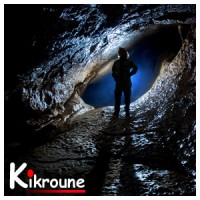SEARCH






|
|
|
|


by Christian Roustan (Kikroune)
Exploration of caves takes us into a world much different from that above ground, a world of darkness surrounded by rock and mud. The biggest challenge for photographers is of course the light.
The only place where some light is to be found in the caves is at the entrance. But as soon as you go a bit deeper into the entrails of this underground world, then you encounter absolute darkness. At first this will appear to be major difficulty, but it is also an advantage: no more need to worry about the light conditions at different times of the day.
Here, like in a studio, the photographer has total control over the lighting setup, which enlarges the creative possibilities. He can’t use the existing light but he imposes the light conditions. The only difference with studio shooting is that she has to transport her material to a rather hostile environment.
This freedom of lighting possibilities opens up two types of photography. First of all, scientific photography, which tries to make neutral photos where all elements are realistically represented. In this case the lighting has to be as homogenous as possible.
But one can also make artistic photos. In this case it is not necessary to illuminate the entire scene, but rather to choose a particular situation or gallery. The light now becomes a source of creativity; one can use back lighting to emphasize relief or to accentuate shadows and light.
The sources of lighting
To illuminate large spaces, certain speleologists don’t hesitate to use ancient techniques such as magnesium flash powder, which is an explosive mixture of magnesium, potassium chlorate and sulfuric acid. This is the ancestor of the electronic flash and has an enormous advantage because it produces an intense light without being focused, which is very useful in large spaces. The inconvenience is that it produces a lot of smoke, which makes taking more photographs impossible. The old flashbulbs have known their glory days; they were capable of producing an intense light (guide number of more than 100 with an angle of more than 180°), which is much superior to the electronic flashlights of today. Unfortunately these flashbulbs are no longer produced and can no longer be found.
The electronic flash is therefore the base for all speleology photographers. The advantage is that it is compact and handy. For large spaces it remains a handicap because its power hasn’t improved sufficiently.
Lately very powerful LED lights have appeared on the market. They have almost replaced all older light units, which were based on acetylene. Their larger power could be used for photography, but their rendition of color is often quite bad. The CRI (color rendering index) of these lamps is around 70, whereas for photography it is recommended to use CRIs above 90. LED flashlights for video could be a source of complementary lighting. They are relatively compact and light, their CRI is more than 90 and the color temperature generally is 4500°K, which allows for electronic flash units to be used simultaneously.
Team travel
Cave exploration is not something to be improvised. One needs an excellent knowledge of the environment and of the possible risks. One also needs technical equipment, such as ropes, inflatable boats, and a docking system. Most of the explorations need several bags of material, which cannot be carried by one person, especially when that person is a photographer.
The photographer is dependent on his team to carry his material but this dependency doesn’t only involve the transport of material but also assistance when taking photographs. I like the following quote of Raymond Depardon: “Il faut aimer la solitude quand on veut être photographe”. One must love solitude when one wants to be a photographer.
This citation might sound contradictory for a team sport, but it’s very true for speleology. The speleologist is alone when he climbs up his cord, he is alone in the narrow passages where he has the feeling of being trapped and he is alone when he is faced with fatigue. He is alone but he has a team around him on which he can count.
 | Write |
 | Edith Hoffman Great read about your cave shoots Christian and good to know the background behind your photographs. You also developed your own style and theme. How did you get this idea to go and shoot in caves or is it your job? Just curious hahaha.... Thanks for sharing and have a great rest of the week :-) |
 | Christian Roustan (Kikroune) Edith, thank you for your interest on this article.
I am fortunate to live in a southern region of France where there are many caves, being young I was fascinated by geology and so I started caving at the age of 14 years.
It's a bit later I started photography and directed several slideshows at the time of analog photography, it was in the 80s.
This is not my job, I am an electronic engineer, but it's a passion that occupies my leisure :)
Have a nice end of week too ;) |
 | Edith Hoffman You are welcome Christian and looking forward to seeing more of your cave photography. You also have to passions in one, like me. So many things to try and explore, well have fun my friend :-) |